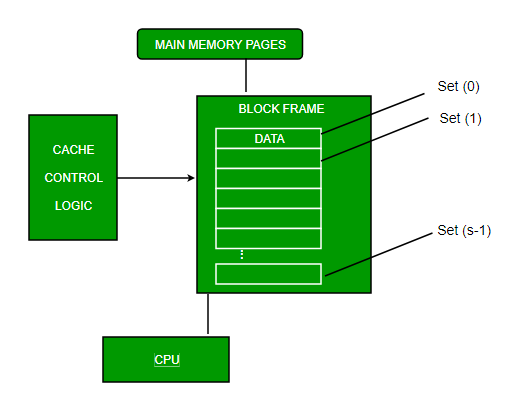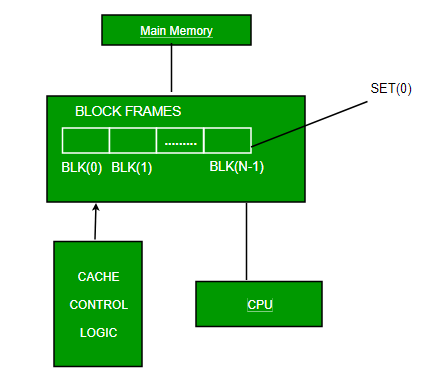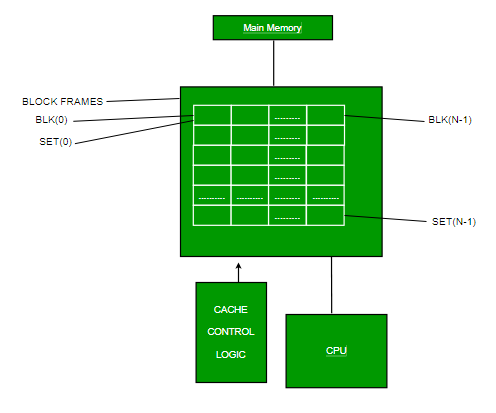Cache Mapping Techniques
Last Updated :
18 Mar, 2024
Cache mapping is a technique that is used to bring the main memory content to the cache or to identify the cache block in which the required content is present. In this article we will explore cache mapping, primary terminologies of cache mapping, cache mapping techniques I.e., direct mapping, set associative mapping, and fully associative mapping. Let’s start exploring the topic “Cache Mapping”.
Primary Terminologies
Some primary terminologies related to cache mapping are listed below:
- Main Memory Blocks: The main memory is divided into equal-sized partitions called the main memory blocks.
- Cache Line: The cache is divided into equal partitions called the cache lines.
- Block Size: The number of bytes or words in one block is called the block size.
- Tag Bits: Tag bits are the identification bits that are used to identify which block of main memory is present in the cache line.
- Number of Cache Lines: The number of cache lines is determined by the ratio of cache size divided by the block or line size.
- Number of Cache Set: The number of cache sets is determined by the ratio of several cache lines divided by the associativity of the cache.
What is Cache Mapping?
Cache mapping is the procedure in to decide in which cache line the main memory block will be mapped. In other words, the pattern used to copy the required main memory content to the specific location of cache memory is called cache mapping. The process of extracting the cache memory location and other related information in which the required content is present from the main memory address is called as cache mapping. The cache mapping is done on the collection of bytes called blocks. In the mapping, the block of main memory is moved to the line of the cache memory.
Need for Cache Mapping
Cache mapping is needed to identify where the cache memory is present in cache memory. Mapping provides the cache line number where the content is present in the case of cache hit or where to bring the content from the main memory in the case of cache miss.
Important Points Related to Cache Mapping
Some important points related to cache mappings are listed below.
- The number of bytes in main memory block is equal to the number of bytes in cache line i.e., the main memory block size is equal to the cache line size.
- Number of blocks in cache = Cache Size / line or Block Size
- Number of sets in cache = Number of blocks in cache / Associativity
- The main memory address is divided into two parts i.e., main memory block number and byte number.
Cache Mapping Techniques
There are three types of cache mappings namely:
- Direct Mapping
- Fully Associative Mapping
- Set Associative Mapping
Direct Mapping
In direct mapping physical address is divided into three parts i.e., Tag bits, Cache Line Number and Byte offset. The bits in the cache line number represents the cache line in which the content is present whereas the bits in tag are the identification bits that represents which block of main memory is present in cache. The bits in the byte offset decides in which byte of the identified block the required content is present.
|
Tag
|
Number of Cache Lines
|
Byte Offset
|
Cache Line Number = Main Memory block Number % Number of Blocks in Cache

Fully Associative Mapping
In fully associative mapping address is divided into two parts i.e., Tag bits and Byte offset. The tag bits identify that which memory block is present and bits in the byte offset field decides in which byte of the block the required content is present.

Set Associative Mapping
In set associative mapping the cache blocks are divided in sets. It divides address into three parts i.e., Tag bits, set number and byte offset. The bits in set number decides that in which set of the cache the required block is present and tag bits identify which block of the main memory is present. The bits in the byte offset field gives us the byte of the block in which the content is present.
|
Tag
|
Set Number
|
Byte Offset
|
Cache Set Number = Main Memory block number % Number of sets in cache

Frequently Asked Questions on Cache Mapping – FAQs
What is Cache Memory?
Cache memory is small and fast memory that works on the principle of locality of reference. It stores the frequently accessed content or the contents nearby the frequently accessed content present in the main memory. It is present between the CPU and RAM to make the content access faster.
What Do You Mean by Tag Directory?
The tag directory stores the tag bits and additional bits for each cache line.
What Do You Mean by Cache Hit or Cache Miss?
When the required content is present in the cache memory then, it is called cache hit. If the required content is not present in the cache memory it is called cache miss.
What is the Formula to Calculate Hit Ratio?
The formula to calculate hit ratio is:
Hit Ratio = Number of cache hits / Total number of references
What is the Index Part in Direct Mapping, Set Associative Mapping, Fully Associative Mapping?
The index parts of different mapping techniques are listed below:
Index in Direct Mapping = Cache Line Number
Index in Set Associative Mapping = Set Number
Index in Set Associative Mapping = 0
Share your thoughts in the comments
Please Login to comment...